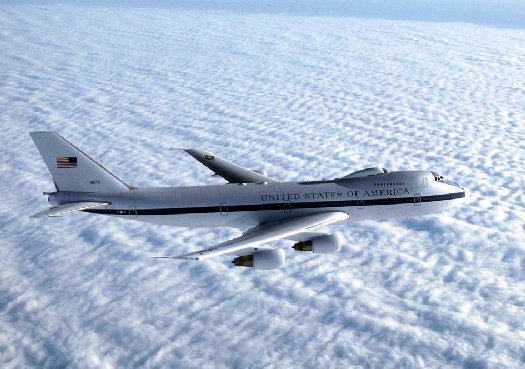

| Aircraft | E-4B (Boeing Aerospace Co.) |
| Type | Airborne operations center |
| Year | January 1980 (E-4B) |
| Engine | Four General Electric CF6-50E2 turbofan engines : 52,500 pounds of thrust each engine |
| Wingspan | 195 feet, 8 inches (59.7 meters) |
| Length | 231 feet, 4 inches (70.5 meters) |
| Height | 63 feet, 5 inches (19.3 meters) |
| Weight | 800,000 pounds (360,000 kilograms) |
| Endurance | 12 hours (unrefueled) |
| Ceiling | Above 30,000 feet (9,091 meters) |
| Crew | Up to 114 |
| Armament | None < |
The E-4B serves as the National Airborne Operations Center for the National Command Authorities. In case of national
emergency or destruction of ground command control centers, the aircraft provides a modern, highly survivable, command,
control and communications center to direct U.S. forces, execute emergency war orders and coordinate actions by civil
authorities.
Air Combat Command (ACC) is the Air Force single-resource manager for the E-4B, and provides aircrew, maintenance,
security and communications support. The Joint Chiefs of Staff actually control E-4B operations and provide personnel for the
airborne operations center.
The E-4B, a militarized version of the Boeing 747-200, is a four-engine, swept-wing, long-range, high-altitude airplane capable
of being refueled in flight. Its larger size provides approximately triple the floor space of the earlier EC-135 command post.
The main deck is divided into six functional areas: a National Command Authorities' work area, conference room, briefing
room, an operations team work area, and communications and rest areas. An E-4B crew may include up to 114 people,
including a joint-service operations team, an ACC flight crew, a maintenance and security component, a communications team
and selected augmentees.
The E-4B has electromagnetic pulse protection, an electrical system designed to support advanced electronics and a wide
variety of new communications equipment. Other improvements include nuclear and thermal effects shielding, acoustic control,
an improved technical control facility and an upgraded air-conditioning system for cooling electrical components. An advanced
satellite communications system improves worldwide communications among strategic and tactical satellite systems and the
airborne operations center.
To provide direct support to the National Command Authorities, at least one E-4B is always on alert at one of many selected
bases throughout the world.
The E-4B evolved from the E-4A, which had been in service since late 1974. The first B model was delivered to the Air Force
in January 1980, and by 1985 all aircraft were converted to B models. All E-4B are assigned to the 55th Wing, Offutt Air
Force Base, Neb.
In August 1994, the E-4B assumed an additional role. With the approval of JCS chairman, the E-4B will support the Federal
Emergency Management Agency's request for assistance when a natural disaster, such as hurricane, typhoon or earthquake
occurs. The E-4B would be tasked to fly the FEMA Emergency Response to the disaster site, and become the FEMA
command and control center until the emergency team's own equipment and facilities can be set up. With E-4B support the
emergency team's response is a matter of hours as opposed to days.
Source-United States Air Force